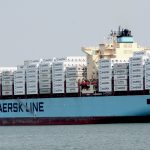Hanjin Asia-U.S. Assets for Sale & What It Means
Hanjin Container Ship Photo by: Flickr user Ingrid Taylar
Well, this might be a little bit early--notices are reported to start going up tomorrow at the earliest--but Hanjin Shipping’s Asia-U.S. operations are going up for sale.
The Wall Street Journal reports:
The South Korean bankruptcy court handling Hanjin Shipping Co.’s insolvency proceedings said Thursday it plans to dispose of the firm’s sales and marketing network for its Asia-U.S. route, in an effort to raise funds and help rehabilitate the indebted company.
A spokesman for the Seoul Central District Court overseeing Hanjin Shipping’s receivership said assets currently set to be put up for sale include the entire operations of Hanjin Shipping’s U.S. to Asia routes such as manpower systems, five container ships, and 10 overseas businesses.
Hanjin Shipping received court approval to seek buyers for assets in order to pay back creditors now in the process of making claims until October 25….
The spokesman for the Seoul Central District Court said the deadline for binding bids is expected to be Nov. 7.
Hanjin Shipping’s collapse is the biggest bankruptcy in the history of the international shipping industry, and it has caused much uncertainty. Years of overcapacity and billion dollar losses by carriers inevitably had to lead to a major bankruptcy like this. However, many thought governments would keep bailing these giant companies out, continuing the “too big to fail” fallacy.
As Hanjin Shipping shrinks or gets completely bought out or dissolved, other shipping companies will get bigger.
The industry’s biggest player, and largest carrier by capacity, Maersk is splitting into two divisions with its new shipping division focusing on acquiring struggling shipping lines.
Many speculated Maersk would buy Hanjin’s assets, but Maersk’s strategy seems more predatory than that. Maersk isn’t looking to get bigger for the sake of getting bigger; the company is looking to shrink the competition pool. Expect Maersk to buy out struggling carriers before they collapse like Hanjin.
If not Maersk, which company is most likely to buy out Hanjin’s assets that are going on sale?
The Wall Street Journal article points to the other big South Korean shipping company, HMM:
Hanjin’s Korean peer Hyundai Merchant Marine Co. will be the first to assess Hanjin’s 37 container vessels. Government officials have said they would back Hyundai in buying Hanjin assets, provided such a move would help it stay competitive.
This really represents a reversal of fortunes for HMM.
HMM was headed for receivership itself in May. With a major restructuring deal on its debt, HMM has managed to escape bankruptcy and possibly see major growth with the acquisition of Hanjin assets. Hanjin was the larger of the two major Korean shipping carriers and included in a new major carrier alliance while HMM was excluded. Hanjin’s collapse shakes up carrier alliances and makes HMM likely to have more than one alliance suitor.
All that is not to say that HMM is in great financial health now. In fact, no carrier really seems to be in good financial health according to Drewry research. The maritime research company’s Z-score index shows almost all major carriers reside in a financial stress zone, and even Maersk is in a cautionary “grey zone”.
The financial health crisis carriers face make another collapse like Hanjin’s likely. But even more likely is Maersk swooping in to devour struggling shipping lines with acquisitions before they collapse.
Other carriers watch Maersk and emulate what it does. Don’t be surprised when other carriers look for opportunities to acquire competing shipping lines as well.
Hanjin’s collapse and the purchasing of its assets can be viewed as a preview of what’s to come in the international shipping industry.
Expect to see fewer major players in the international shipping industry in the upcoming years while the major carriers that remain grow even larger.




